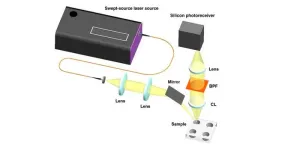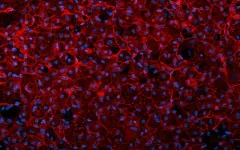(Press-News.org) NEW YORK – April 4, 2024 – The Cardiovascular Research Foundation® (CRF®) is excited to introduce New York Valves: The Structural Heart Summit, the expanded next iteration of our renowned annual Transcatheter Valve Therapy (TVT®) conference. Taking place June 5-7, 2024, at the Jacob K. Javits Convention Center, North in New York City, the new summit will be a world-class educational experience in the field of structural heart interventions.
“New York Valves 2024 signifies an important milestone for our organization,” said Juan F. Granada, MD, President and Chief Executive Officer of CRF® and New York Valves Program Director. “For the first time, this meeting will provide a unique interactive environment for networking, collaboration, and education, including all members of the heart team. It offers practitioners an unprecedented opportunity to learn about the latest developments in each specific area of our field. Through real multi-specialty collaboration, this summit will not only advance our knowledge but also directly impact patient care worldwide."
For nearly two decades, CRF® has led the way in pioneering transcatheter therapies for structural heart disease at TVT®. New York Valves marks the next iteration of this legacy, featuring three days of transformative research and techniques that will redefine the landscape of structural heart interventions. It’s the premier gathering uniting interventional cardiologists, cardiac surgeons, clinical cardiologists, cardiac imagers, heart failure experts, and other members of the heart team under one roof. With a renewed emphasis on multidisciplinary collaboration, New York Valves offers attendees the opportunity to harness the collective expertise of all specialties to develop the most effective and personalized treatment strategies for patients with valvular and structural heart disease.
“New York Valves 2024 is more than just a meeting; it's a multidisciplinary movement reshaping the landscape of cardiovascular care in patients with valvular and structural heart disease,” said Martin B. Leon, MD, Founder and Chairman Emeritus of CRF® and New York Valves Program Director. “From novel therapies to best clinical practices, this summit embodies the evolution of transcatheter and surgical interventions. Our goal is to unite specialists from every corner of cardiovascular care to extend the heart team, redefine innovations, and develop new standards for managing valve patients."
Transcatheter valve therapy has evolved from a novel treatment for the sickest patients to become the standard of care for many with aortic stenosis. The rapid adoption of transcatheter mitral and tricuspid therapies has also transformed the treatment landscape, expanding options for patients with structural heart disease.
New York Valves 2024 will showcase advanced techniques and evidence-based medicine through live-case demonstrations, hands-on training, lively debate, and the latest updates that contribute knowledge to the field. With a distinguished lineup of world-renowned experts, this comprehensive program is designed as a practical, case-based course that will delve into best practices, clinical decision-making, patient selection, and strategies for devices, imaging, procedures, and complications management. The summit will also feature the latest breakthroughs and research in the field providing attendees with an unparalleled opportunity to explore the newest techniques and technologies in structural heart interventions.
About CRF®
The Cardiovascular Research Foundation® (CRF®) is a global leader in interventional cardiovascular medicine, driving innovation, spearheading groundbreaking research, and transforming education in the field. Through its relentless pursuit of excellence, CRF® not only accelerates medical breakthroughs but also equips healthcare professionals with the tools and knowledge necessary to enhance survival rates and elevate the quality of life for millions worldwide. CRF’s centers of excellence include the CRF Skirball Center for Innovation, CRF Clinical Trials Center, CRF Center for Education, CRF Digital, TCTMD, and Structural Heart: The Journal of the Heart Team. For more information, visit www.crf.org.
###
END
Mixing livestock and crops, integrating flower strips and trees, water and soil conservation and much more: Massive new global study led by the University of Copenhagen and University of Hohenheim, has examined the effects of diversified agriculture. The conclusion is abundantly clear – positive effects increase with every measure, while negative effects are hard to find.
Laura Vang Rasmussen of the University of Copenhagen can finally wipe the sweat from her brow. For the last four years, she has served as the link between 58 researchers on five continents and as lead author of a major agricultural study which gathered ...
In 1928, Indian physicist Sir C. V. Raman and his colleague K. S. Krishnan discovered that when light interacts with matter, parts of the scattered light undergo changes in energy due to interaction with molecular vibrations, resulting in what is known as Raman scattering. The discovery laid the foundation for Raman spectroscopy, a technique that takes advantage of these energy changes to create a unique fingerprint of the molecular structure of the material.
Currently, dispersive Raman spectroscopy ...
Argininosuccinate lyase deficiency (ASLD), also known as argininosuccinic aciduria, is a disease that has been enriched in the Finnish genetic heritage. In this severe metabolic disease, the body does not process proteins normally, instead resulting in a very dangerous accumulation of argininosuccinic acid and ammonia. Excess ammonia causes disturbances of consciousness, coma and even death.
In Finland, infants are screened for ASLD to determine the disease risk before symptoms develop. The treatment is an extremely ...
New York (April 4, 2024) — Today, the American Geriatrics Society (AGS) and the AGS Health in Aging Foundation (HiAF) announced that the 2024 Thomas and Catherine Yoshikawa Award for Outstanding Scientific Achievement in Clinical Investigation will be awarded to C. Barrett Bowling, MD, MSPH, Associate Professor in the Division of Geriatrics at Duke University School of Medicine.
The award will be presented at the AGS 2024 Virtual Annual Scientific Meeting (#AGS24), May 9-11 (pre-conference days May 7 & 8). At the conference, Dr. Bowling will deliver a lecture on “Geriatricizing” Chronic Disease Research: A Geriatrician’s ...
During archaeological excavations in the Schöningen open-cast coal mine in 1994, the discovery of the oldest, remarkably well-preserved hunting weapons known to humanity caused an international sensation. Spears and a double-pointed throwing stick were found lying between animal bones about ten meters below the surface in deposits at a former lakeshore. In the years that followed, extensive excavations have gradually yielded numerous wooden objects from a layer dating from the end of a warm interglacial period 300,000 years ago. The findings suggested a hunting ground on the lakeshore. An interdisciplinary ...
Bacterial proteins often play a successful hide and seek game with the body’s immune system, making it difficult to combat the bacteria that cause diseases like staph infections.
Now, biomolecular engineer Aditya Kunjapur and colleagues have come up with a strategy to create bacteria that build and incorporate a key amino acid into their own proteins, which makes the proteins more “visible” to the immune system.
For this work toward building a better platform for possible future bacterial vaccines, Kunjapur is the winner of the 2024 BioInnovation Institute & Science Prize for Innovation. ...
A flexible electronic fiber that utilizes the human body as part of the circuit enables textile-based electronics without the need for batteries or chips, researchers report. According to the authors, the approach is well-suited for scalable manufacture of comfortable fiber-based electronics for a wide range of applications, including “smart” clothing. Textile electronic systems are designed to equip textile or fiber assemblies with electronic functions for sensing, computation, display, or communication. They create vast opportunities ranging from physiological monitoring to powering ...
In this Policy Forum, Michael Cohen and colleagues highlight the unique risks presented by a particular class of artificial intelligence (AI) systems: reinforcement learning (RL) agents that plan more effectively than humans over long horizons. “Giving [such] an advanced AI system the objective to maximize its reward and, at some point, withholding reward from it, strongly incentivizes the AI system to take humans out of the loop,” write Cohen and colleagues. This incentive also arises for long-term planning agents (LTPAs) more generally, say the authors, and in ways empirical testing is unlikely to cover. It is thus critical to address extinction risk from these ...
In asthma, the tightening of muscles around the bronchi causes damage to the airway by squeezing and destroying epithelial cells, which promotes the airway inflammation and mucus production often associated with an asthma attack, researchers report. The findings suggest that preventing the mechanical damage caused by an asthma attack, rather than treating only its downstream symptoms, could pave the way for therapies that stop the whole asthma inflammatory cycle. Asthma is a common airway disorder affecting more than 300 million people worldwide. Although it is primarily considered an inflammatory disease, a diagnostic feature of asthma is mechanical bronchoconstriction – the ...
Promoting livestock biodiversity and soil conservation strategies provides both social and environmental benefits, according to a new study. The findings suggest that well-designed polices aimed at incentivizing the adoption of multiple diversification strategies could mitigate simplified agriculture’s negative environmental, health, and social impacts. “Our interdisciplinary analysis spanning a wide array of regions provides convincing evidence that agricultural diversification is a promising win-win strategy for providing social and environmental benefits,” write the authors. Agricultural lands tend to be simplified ecosystems designed ...


